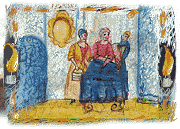|


| Many
are the dangers which threaten mother and child in the period immediately
following delivery. Folk belief ascribes these dangers to demons and evil
spirits which lie in wait to pounce on them and snatch away their lives.
In Jewish, as in other folk traditions, various inanimate substances —
among them earth, water, precious stones, metal objects - were used as
means of protection. We will look in this article at fire and the role
it played as a protection for mother and child. |
The custom of lighting fire or a candle for the woman in childbed is found among
many peoples. According to Jewish legend, there is a connection between fire,
which is a sacred symbol of life and fertility, and the child while it is in
its mother's womb.
R. Levi said: .... "It is usual in the world that nobody pays attention
to a man who is imprisoned in the jailhouse. If somebody comes and lights a
candle for him, the prisoner will be very grateful to him. So the Holy One,
blessed be He. The embryo dwells in its mother's womb, and God lights for it
a candle there. This is what Job says: "When His lamp shined above my head"
(Job 29:3).[1]
As long as the child is in the womb, this candle rests on his head; when he
comes out [i.e., is born], an angel taps him on the nose and puts out the candle
which is over his head."[2]
The candle also symbolizes the child itself. Rav Huna, it is related in the
Talmud, used to pass by the door of R. Abin the carpenter. He saw that R. Abin
had the habit of lighting good candles on the eve of the Sabbath, and said,
"Two great men will come from here." And there issued from R. Abin
— Rav Idi ben Abin and Rav Hiyya bar Abin.
It is also reported of Rav Hisda that he used to pass by the door of the parents
of Rav Shizvi. He saw that they lighted five candles, and he said, "A great
man will issue from here." And Rav Shizvi issued from them. Rav Huna used
to quote the proverb, "He who regularly lights the Shabbat candle, his children
will become scholars."[3]
Similar views were echoed in recent generations. "Through the Hanukkah candles
and the Sabbath candles, a man will have sons who will become scholars,"
and, "Thanks to paying attention to the candles a man will merit that his
wife bear male children."[4]
 In talmudic times such importance
was attached to the lighting of candles for a woman in childbed that the rabbis
permitted it even on the Sabbath, and even for a blind woman if she asked that
a birth candle be lit during her delivery.[5]
That last-mentioned details shows that the candle served as a charm for ensuring
successful delivery and as a protection for the lives of mother and child. The
same purpose was served by lighting a fire for the woman in childbed for thirty
days, "even in the period of Tammuz" (that is, in midsummer when it
was certainly not needed for warmth).[6]
In ancient Rome they lighted
a candle in the room of the woman in confinement to drive away the demons, and
the same custom is practiced in modern Greece.
In talmudic times such importance
was attached to the lighting of candles for a woman in childbed that the rabbis
permitted it even on the Sabbath, and even for a blind woman if she asked that
a birth candle be lit during her delivery.[5]
That last-mentioned details shows that the candle served as a charm for ensuring
successful delivery and as a protection for the lives of mother and child. The
same purpose was served by lighting a fire for the woman in childbed for thirty
days, "even in the period of Tammuz" (that is, in midsummer when it
was certainly not needed for warmth).[6]
In ancient Rome they lighted
a candle in the room of the woman in confinement to drive away the demons, and
the same custom is practiced in modern Greece.
Jewish
custom requires that the newborn be received when a lighted candle when
it emerges from the womb. In many parts of the Diaspora the custom is
to light a candle or candles next to the woman in childbed.[7]
In several Jewish communities it is explicitly acknowledged that this
custom is intended to save or protect the lives of mother and child. Thus,
among the Bene Israel [India], a dim lamp is left burning in the room
of the woman in confinement so that the newborn should not acquire a squint
or suffer damage in its sight.[8]
Among the Jews of Damascus, "at night one is careful not to leave
the woman in childbed in the dark at all, and therefore they light a candle
next to her."[9]
Among the Sephardim in Safed, "if the woman has difficulties in delivery,
they light candles in her room for the exaltation of the souls of Moshe
Ben Maimon and R. Shimon bar Yohai, may their merits protect us, Amen."[10]
The underlying belief hinted at in these Jewish sources is expressed explicitly
in the customs of primitive peoples.
The symbolic value of the candle and the fire in connection with childbirth
is expressed also in the strict prohibition against taking fire in any
form out of the confinement room. Although this prohibition applies to
all objects found in the room or the house, its application to fire is
specifically and emphatically stressed. [11]
Among the Polish Jews, "The women do not allow that fire or any burning
thing, such as a lighted papirusa [cigarette], should be taken
out of the confinement room, saying, "It is forbidden that fire should
go out of the confinement room" [in the original Yiddish, Fun
a kinpetarin's shtub tar keyn feyer nisht aroysgehn]."[12]
The Jews of Jerusalem also emphasize that fire, especially, must not be
taken from the house of the woman in childbed."[13]
Chorny reports from the Jews of Derbent that "it is forbidden to
take fire out of that house, and it is also forbidden to borrow any vessel
from it."[14]
Among the Kurdish Jews, it is forbidden for outsiders to use anything
from the house of the woman in childbirth in the first week after birth;
it is also forbidden to lend a vessel or take out fire."[15]
Among the Jews of Yemen and Aden, it is forbidden to take anything out
of the house of the woman in confinement, and this prohibition is especially
strict in relation to fire.[16]
The same prohibition is observed in Palestine among the Jews of the old
Yishuv, the settlers before 1882: "And likewise they will not take
on loan anything from the house of the woman in childbed during the first
week. Especially fire must not be taken from her house."[17]
A Palestinian Arab custom shows most clearly that the candle stands for
the newborn. When a child is sick, its parents vow to give the mosque
a candle as long as the child's height.
Fumigation, too, provides protection for mother and child. Maimonides
decried this custom, in which he saw a remnant of the pagan rite of passing
the child through fire for Moloch, which was adopted by idolatrous Israelites
in biblical times from their pagan neighbors. "And know that traces
of this practice have survived even to the present day, because it was
widespread in the world. You can see how midwives take a young child wrapped
in swaddling clothes, and have placed incense of a disagreeable smell
on the fire, swing the child in the smoke over that fire. This is certainly
a kind of 'passing children through the fire,' and we must not do it."[18]
However, as in many other cases, folk custom proved stronger than rabbinical
admonition and prohibition, and the fumigation of mother and child has
continued to occupy an important place among the apotropaic measures resorted
to by many Jewish communities. The Jews of Yemen, for example, burn incense
on the day of birth, on the spot where the delivery took place, on the
third day after birth under the body of the mother, and on the fifth day
under all women guests and over seven doors of the house."[19]
Among the Jews of Aden, the woman puts incense on the fire, takes the
newborn, and swing it over the smoke[20]
— thus practicing the precise custom outlawed
by Maimonides eight centuries earlier. Such fumigations are practiced
among several people.[21]
|
[1]
Lev. Rab. 14:2 [back]
[2] Seder Y'zirat ha-Valad, in Jellinek,
Bet Hamidrash 1:154; see also The Chronicles of Jerahmeel
(London, 1899) [back]
[3] B. Shab. 23b [back]
[4] Sefer Hamiddot, s.v. Banim,
no. 54 [back]
[5] B. Shab. 128b [back]
[6] Y. Shab. 16c [back]
[7] J.D. Eisenstein, ed. Ozar Yisrael,
10 vols. [back]
[8] Kehimkar, Bene Israel, p. 113
[back]
[9] Written communication from R. Eliyahu
Ma'aravi of Damascus [back]
[10] Oral communication from Hakham Shimon
Harus of Safed [back]
[11] Hartland in Encuclopedia of Religion
and Ethics 2:638 [back]
[12] Elzaet, in Reshumot 1:362 [back]
[13] Luncz, Yerushalayim 1:27; Reischer,
Sefer Shaarei Yerushalayim 9 (Minhag Aretz) [back]
[14] Chorny, Sefer ha-Massaot, p. 296;
Kasdai, Mamlekhet Ararat, pp. 55-56 [back]
[15] Brauer, Yehudei Kurdistan,
p. 133 [back]
[16] Brauer, Ethnologie, p. 187
[back]
[17] Luncz, Yerushalayim 1:27; Stern,
Medizin, 2:317-318 [back]
[18] Maimonides, Guide for the Perplexed
3, chap. 27 (transl. Friedlander, p. 178) [back]
[19] Brauer, Ethnologie, pp. 186-88
[back]
[20] ibid. [back]
[21] Lane, Manners and Customs,
1:316; Stern, Medizin, 2:312 [back] |
|
 From
On Jewish Folklore by Raphael Patai. Copyright © 1983
by Wayne State University Press. Reprinted by permission
of the publisher. From
On Jewish Folklore by Raphael Patai. Copyright © 1983
by Wayne State University Press. Reprinted by permission
of the publisher.
|
FIRE
Table of Contents
|